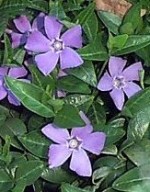
Also called myrtle and the Virgin flower this perennial evergreen vine is a member of the dogbane family, Apocynaceae, that also includes milkweed, oleander, and bluestar. It is native from central and southern Europe to the Baltic States and southwestern Asia in Turkey where it grows in fields and woodland edges. Non-flowering stems root at all the nodes so that it quickly spreads to form a dense low growing mat. The glossy, dark green leaves are leathery and up to 1.5″ long. Bright blue tubular flowers are .75-1” across and are born in spring and sometime sporadically in summer and fall. White and purple flowered cultivars and varieties are available but would not be as suitable for a Mary garden as the sky-blue flowered variety. Photo Credit Wikipedia
The relationship between periwinkle and Mary begins in the book of Numbers 4. 6-7 in Old Testament of the Bible.
6 And shall put thereon the covering of badgers’ skins [fine leather], and shall spread over it [the Ark of the Covenant] a cloth wholly of blue, and shall put in the staves thereof.
7 And upon the table of shewbread they shall spread a cloth of blue, and put thereon the dishes, and the spoons, and the bowls, and covers to cover withal: and the continual bread shall be thereon:
Since Mary became the NEW Ark of the Covenant, she was associated with the color blue . This association was enhanced by the fact that periwinkle were the color of the sky/heaven so became symbols of Jesus, Mary and the angels in heaven
Periwinkle prefers some shade and fertile, moist, well-drained soil, but also does well in dry soil. Plants are generally healthy but are susceptible to blight, canker, dieback and leaf spot. Propagation is by division and terminal cuttings of non-flowering stems. Periwinkle is a good choice for a ground cover, controlling erosion, and containers like window boxes where its cascading nature can be appreciated. It is hardy in USDA Hardiness Zones 4-9
The genus name, Vinca, is from the Latin word vincire meaning to bind/wind around, and refers to the use of the plant in ancient times to make into wreath. The specific epithet, minor, is the Latin word meaning less and refers to the the size of the leaf compared to those of another species, Vinca major.